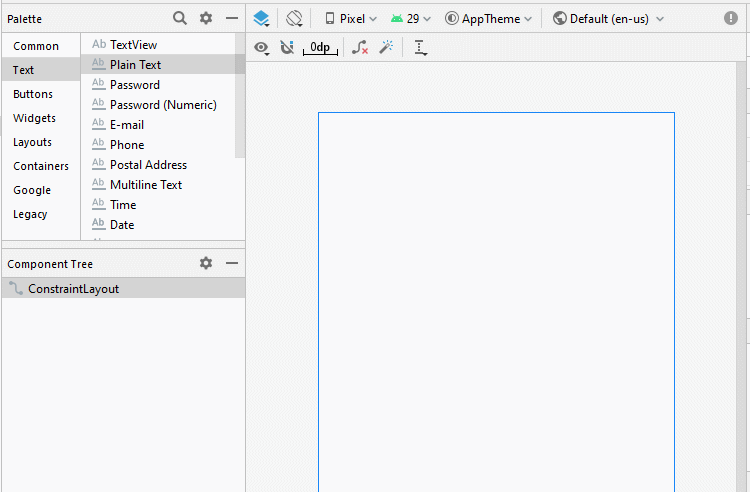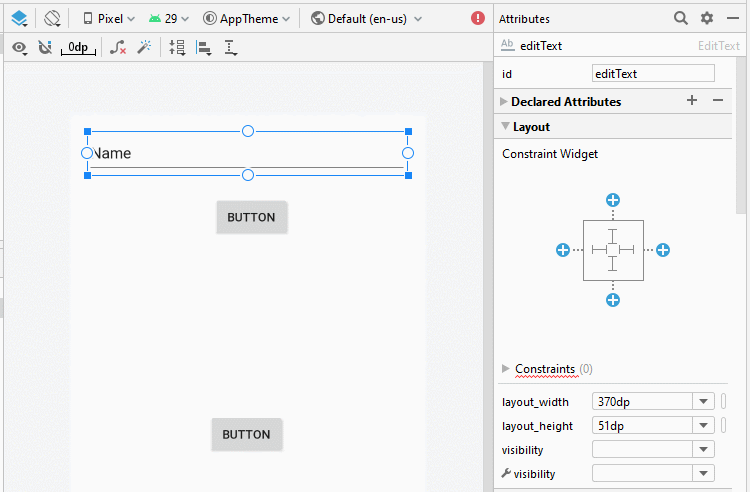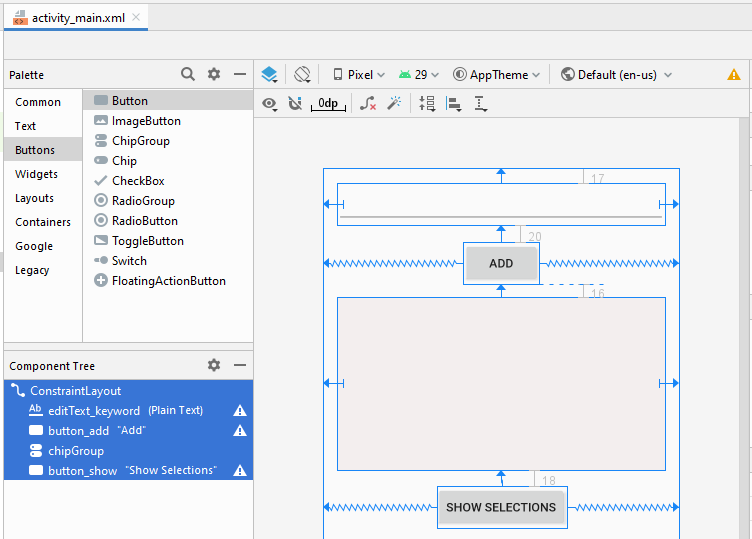Exemple ChipGroup et Chip Entry
1. Le but de l'exemple
Dans cette leçon, je vais vous montrer comment créer une application Android à l'aide de ChipGroup et Chip Entry. Ce n'est qu'un petit exemple, il n'y aura donc pas beaucoup d'explications sur ChipGroup et Chip, si vous voulez une explication complète, veuillez vous référer à l'article ci-dessous:
La caractéristique d'une Chip Entry est qu'elle peut être check (checkable) et que son icône est fermée (close Icon), elle convient donc à certaines applications similaires aux exemples de cet article.
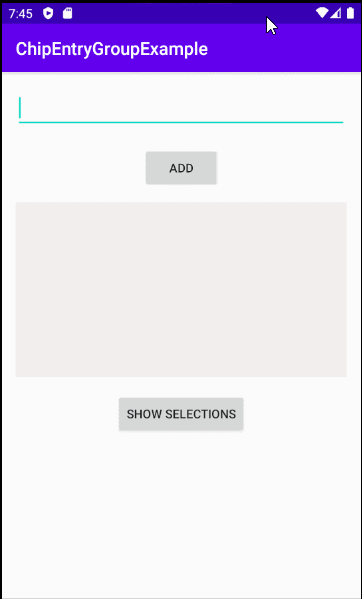
2. Par exemple ChipGroup et Chip Entry
Sur Android Studio, créez un nouveau projet:
- File > New > New Project > Empty Activity
- Name: ChipEntryGroupExample
- Package name: org.o7planning.chipentrygroupexample
- Language: Java
Tout d'abord, vous devez installer la bibliothèque de Chip dans votre projet:
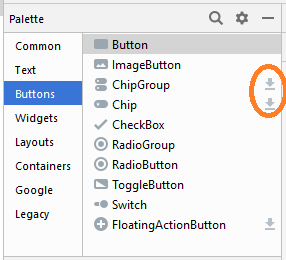
Ou vous pouvez ajouter manuellement la bibliothèque de composants Chip à votre projet:
build.gradle (Module app)
dependencies {
...
implementation 'com.google.android.material:material:1.1.0'
}Faites un clic droit sur le dossier "layout" et sélectionnez:
- New > Layout Resource File
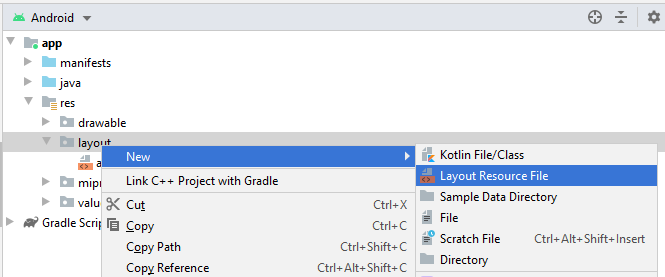
- File name: layout_chip_entry.xml
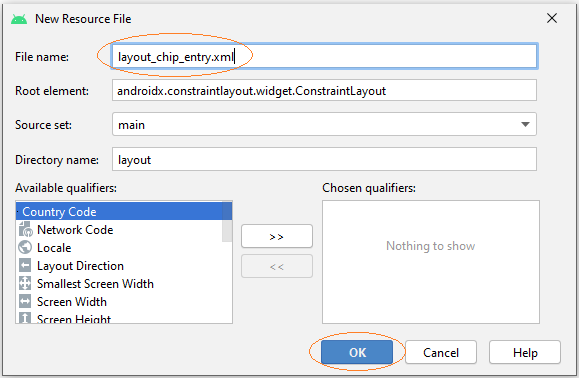
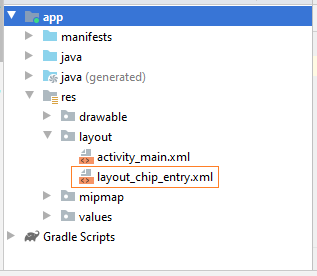
"Layout Resource File" allows you to define a part of the user interface, in this example it is very simple, including only a Chip Entry element.
layout_chip_entry.xml
<?xml version="1.0" encoding="utf-8"?>
<com.google.android.material.chip.Chip
xmlns:android="http://schemas.android.com/apk/res/android"
style="@style/Widget.MaterialComponents.Chip.Entry"
android:theme="@style/Theme.MaterialComponents.Light"
android:layout_width="wrap_content"
android:layout_height="wrap_content"
/>L'interface de l'application:
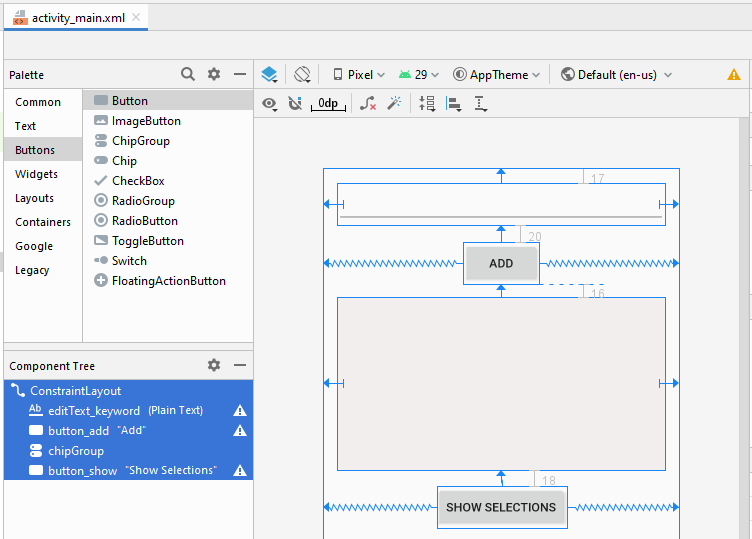
Si vous êtes intéressé par les étapes de conception de l'interface de cette application, consultez l'annexe à la fin de l'article.
activity_main.xml
<?xml version="1.0" encoding="utf-8"?>
<androidx.constraintlayout.widget.ConstraintLayout
xmlns:android="http://schemas.android.com/apk/res/android"
xmlns:app="http://schemas.android.com/apk/res-auto"
xmlns:tools="http://schemas.android.com/tools"
android:layout_width="match_parent"
android:layout_height="match_parent"
tools:context=".MainActivity">
<EditText
android:id="@+id/editText_keyword"
android:layout_width="0dp"
android:layout_height="48dp"
android:layout_marginStart="16dp"
android:layout_marginLeft="16dp"
android:layout_marginTop="17dp"
android:layout_marginEnd="16dp"
android:layout_marginRight="16dp"
android:ems="10"
android:inputType="textPersonName"
app:layout_constraintEnd_toEndOf="parent"
app:layout_constraintStart_toStartOf="parent"
app:layout_constraintTop_toTopOf="parent" />
<Button
android:id="@+id/button_add"
android:layout_width="wrap_content"
android:layout_height="wrap_content"
android:layout_marginTop="20dp"
android:text="Add"
app:layout_constraintEnd_toEndOf="parent"
app:layout_constraintStart_toStartOf="parent"
app:layout_constraintTop_toBottomOf="@+id/editText_keyword" />
<com.google.android.material.chip.ChipGroup
android:id="@+id/chipGroup"
android:layout_width="0dp"
android:layout_height="200dp"
android:layout_marginStart="16dp"
android:layout_marginLeft="16dp"
android:layout_marginTop="16dp"
android:layout_marginEnd="16dp"
android:layout_marginRight="16dp"
android:background="#F3EEEE"
app:layout_constraintEnd_toEndOf="parent"
app:layout_constraintStart_toStartOf="parent"
app:layout_constraintTop_toBottomOf="@+id/button_add" />
<Button
android:id="@+id/button_show"
android:layout_width="wrap_content"
android:layout_height="wrap_content"
android:layout_marginTop="18dp"
android:text="Show Selections"
app:layout_constraintEnd_toEndOf="parent"
app:layout_constraintStart_toStartOf="parent"
app:layout_constraintTop_toBottomOf="@+id/chipGroup" />
</androidx.constraintlayout.widget.ConstraintLayout>MainActivity.java
package org.o7planning.chipentrygroupexample;
import androidx.appcompat.app.AppCompatActivity;
import android.os.Bundle;
import android.view.LayoutInflater;
import android.view.View;
import android.widget.Button;
import android.widget.CompoundButton;
import android.widget.EditText;
import android.widget.Toast;
import com.google.android.material.chip.Chip;
import com.google.android.material.chip.ChipGroup;
public class MainActivity extends AppCompatActivity {
private EditText editTextKeyword;
private ChipGroup chipGroup;
private Button buttonAdd;
private Button buttonShow;
@Override
protected void onCreate(Bundle savedInstanceState) {
super.onCreate(savedInstanceState);
setContentView(R.layout.activity_main);
this.editTextKeyword = (EditText) this.findViewById(R.id.editText_keyword);
this.chipGroup = (ChipGroup) this.findViewById(R.id.chipGroup);
this.buttonAdd = (Button) this.findViewById(R.id.button_add);
this.buttonShow = (Button) this.findViewById(R.id.button_show);
this.buttonAdd.setOnClickListener(new View.OnClickListener() {
@Override
public void onClick(View v) {
addNewChip();
}
});
this.buttonShow.setOnClickListener(new View.OnClickListener() {
@Override
public void onClick(View v) {
showSelections();
}
});
}
private void addNewChip() {
String keyword = this.editTextKeyword.getText().toString();
if (keyword == null || keyword.isEmpty()) {
Toast.makeText(this, "Please enter the keyword!", Toast.LENGTH_LONG).show();
return;
}
try {
LayoutInflater inflater = LayoutInflater.from(this);
// Create a Chip from Layout.
Chip newChip = (Chip) inflater.inflate(R.layout.layout_chip_entry, this.chipGroup, false);
newChip.setText(keyword);
//
// Other methods:
//
// newChip.setCloseIconVisible(true);
// newChip.setCloseIconResource(R.drawable.your_icon);
// newChip.setChipIconResource(R.drawable.your_icon);
// newChip.setChipBackgroundColorResource(R.color.red);
// newChip.setTextAppearanceResource(R.style.ChipTextStyle);
// newChip.setElevation(15);
this.chipGroup.addView(newChip);
// Set Listener for the Chip:
newChip.setOnCheckedChangeListener(new CompoundButton.OnCheckedChangeListener() {
@Override
public void onCheckedChanged(CompoundButton buttonView, boolean isChecked) {
handleChipCheckChanged((Chip) buttonView, isChecked);
}
});
newChip.setOnCloseIconClickListener(new View.OnClickListener() {
@Override
public void onClick(View v) {
handleChipCloseIconClicked((Chip) v);
}
});
this.editTextKeyword.setText("");
} catch (Exception e) {
e.printStackTrace();
Toast.makeText(this, "Error: " + e.getMessage(), Toast.LENGTH_LONG).show();
}
}
// User click on "Show Selections" button.
private void showSelections() {
int count = this.chipGroup.getChildCount();
String s = null;
for(int i=0;i< count; i++) {
Chip child = (Chip) this.chipGroup.getChildAt(i);
if(!child.isChecked()) {
continue;
}
if(s == null) {
s = child.getText().toString();
} else {
s += ", " + child.getText().toString();
}
}
Toast.makeText(this, s, Toast.LENGTH_LONG).show();
}
// User close a Chip.
private void handleChipCloseIconClicked(Chip chip) {
ChipGroup parent = (ChipGroup) chip.getParent();
parent.removeView(chip);
}
// Chip Checked Changed
private void handleChipCheckChanged(Chip chip, boolean isChecked) {
}
}Tutoriels de programmation Android
- Configurer Android Emulator en Android Studio
- Le Tutoriel de Android ToggleButton
- Créer un File Finder Dialog simple dans Android
- Le Tutoriel de Android TimePickerDialog
- Le Tutoriel de Android DatePickerDialog
- De quoi avez-vous besoin pour démarrer avec Android?
- Installer Android Studio sur Windows
- Installer Intel® HAXM pour Android Studio
- Le Tutoriel de Android AsyncTask
- Le Tutoriel de Android AsyncTaskLoader
- Tutoriel Android pour débutant - Exemples de base
- Comment connaître le numéro de téléphone d'Android Emulator et le changer?
- Le Tutoriel de Android TextInputLayout
- Le Tutoriel de Android CardView
- Le Tutoriel de Android ViewPager2
- Obtenir un numéro de téléphone dans Android à l'aide de TelephonyManager
- Le Tutoriel de Android Phone Call
- Le Tutoriel de Android Wifi Scanning
- Le Tutoriel de programmation de jeux Android 2D pour débutant
- Le Tutoriel de Android DialogFragment
- Le Tutoriel de Android CharacterPickerDialog
- Le Tutoriel Android pour débutant - Hello Android
- Utiliser Android Device File Explorer
- Activer USB Debugging sur un appareil Android
- Le Tutoriel de Android UI Layouts
- Le Tutoriel de Android SMS
- Le Tutoriel de Android et SQLite Database
- Le Tutoriel de Google Maps Android API
- Le Tutoriel de texte pour parler dans Android
- Le Tutoriel de Android Space
- Le Tutoriel de Android Toast
- Créer un Android Toast personnalisé
- Le Tutoriel de Android SnackBar
- Le Tutoriel de Android TextView
- Le Tutoriel de Android TextClock
- Le Tutoriel de Android EditText
- Le Tutoriel de Android TextWatcher
- Formater le numéro de carte de crédit avec Android TextWatcher
- Le Tutoriel de Android Clipboard
- Créer un File Chooser simple dans Android
- Le Tutoriel de Android AutoCompleteTextView et MultiAutoCompleteTextView
- Le Tutoriel de Android ImageView
- Le Tutoriel de Android ImageSwitcher
- Le Tutoriel de Android ScrollView et HorizontalScrollView
- Le Tutoriel de Android WebView
- Le Tutoriel de Android SeekBar
- Le Tutoriel de Android Dialog
- Le Tutoriel de Android AlertDialog
- Tutoriel Android RatingBar
- Le Tutoriel de Android ProgressBar
- Le Tutoriel de Android Spinner
- Le Tutoriel de Android Button
- Le Tutoriel de Android Switch
- Le Tutoriel de Android ImageButton
- Le Tutoriel de Android FloatingActionButton
- Le Tutoriel de Android CheckBox
- Le Tutoriel de Android RadioGroup et RadioButton
- Le Tutoriel de Android Chip et ChipGroup
- Utilisation des Image assets et des Icon assets d'Android Studio
- Configuration de la Carte SD pour Android Emulator
- Exemple ChipGroup et Chip Entry
- Comment ajouter des bibliothèques externes à Android Project dans Android Studio?
- Comment désactiver les autorisations déjà accordées à l'application Android?
- Comment supprimer des applications de Android Emulator?
- Le Tutoriel de Android LinearLayout
- Le Tutoriel de Android TableLayout
- Le Tutoriel de Android FrameLayout
- Le Tutoriel de Android QuickContactBadge
- Le Tutoriel de Android StackView
- Le Tutoriel de Android Camera
- Le Tutoriel de Android MediaPlayer
- Le Tutoriel de Android VideoView
- Jouer des effets sonores dans Android avec SoundPool
- Le Tutoriel de Android Networking
- Analyser JSON dans Android
- Le Tutoriel de Android SharedPreferences
- Le Tutorial de stockage interne Android (Internal Storage)
- Le Tutoriel de Android External Storage
- Le Tutoriel de Android Intents
- Exemple d'une Android Intent explicite, appelant une autre Intent
- Exemple de Android Intent implicite, ouvrez une URL, envoyez un email
- Le Tutoriel de Android Service
- Le Tutoriel Android Notifications
- Le Tutoriel de Android DatePicker
- Le Tutoriel de Android TimePicker
- Le Tutoriel de Android Chronometer
- Le Tutoriel de Android OptionMenu
- Le Tutoriel de Android ContextMenu
- Le Tutoriel de Android PopupMenu
- Le Tutoriel de Android Fragment
- Le Tutoriel de Android ListView
- Android ListView avec Checkbox en utilisant ArrayAdapter
- Le Tutoriel de Android GridView
Show More
